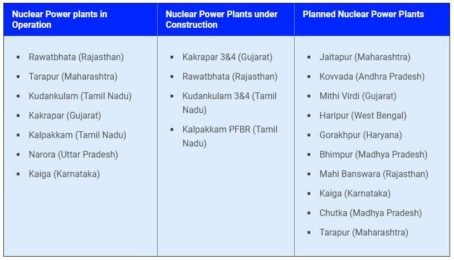Why in news?
Context- India’s nuclear liability law continues to hold up the more than a decade old plan to build six nuclear reactors at Jaitapur in Maharashtra.
About Nuclear power plant at Jaitapur-
– The world’s biggest nuclear power generation plant is about to capacity of 9600Mw.
– Six reactors are constructed on third generation of EPR technology. EPR (European Pressurise Water Reactor)- making safest and most efficient civil nuclear power generator. Use less Uranium
and produce one-third of less radioactive waste.
– The power project is proposed by Nuclear Power Corporation of India Limited (NPCIL) collaboration with French Energy Company (EDF).
– EDF will provide the technology but would not be an investor. NPCIL would be charge in construction.
– India signed civil nuclear deal with 14 countries-Argentina, Australia, Canada, Czech Republic, France, Japan, Kazakhstan, Mongolia, Namibia, Russia, south Korea, UK, USA and Vietnam.
– India is not signatory of NPT (Non-proliferation nuclear treaty) and NSG (nuclear supplier group)
– France is the first country to sign civil nuclear agreement with india.
Nuclear liability law in India-
– Laws on civil nuclear liability ensure that compensation is available to the victims for nuclear damage caused by a nuclear incident or disaster and set out who will be liable for those
damages. the international nuclear liability regime consists of multiple treaties and was strengthened after the 1986 Chernobyl nuclear accident.
– The umbrella convention on supplementary compensation (CSC) was adopted in 1997 with the aim of establishing a minimum national compensation amount. The amount can further be increased
through public funds, (to be made available by the contracting parties), should the national amount be insufficient to compensate the damage caused by a nuclear incident.
– Even though India was a signatory to CSC, parliament ratified the convention, India enacted the Civil Liability for Nuclear Damage Act (CLNDA) in 2010, to put in place a speedy compensation
mechanism for victims of a nuclear accident.
– The CLNDA provides for strict and no-fault liability on the operator of the nuclear plant, where it will be held liable for damage regardless of any fault on its part. It also specifies the
amount the operator will have to shell out in case of damage caused by an accident at Rupees 1500 crore and requires the operator to cover liability through insurance or other financial
security. In case the damage claims exceed Rupees 1500 crore, the CLNDA expects the government to step in and has limited the government liability amount to the rupee equivalent of 300
million Special Drawing Rights (SRDs) or about rupees 2100 to 2300 crore. The act also specifies the limitations on the amount and time when action for compensation can be brought against
the operator.
Supplier liability in CLAND-
– Two other points of rationale were also stated while accepting the exclusive operator liability principle- one was to avoid legal complications in establishing separate liability in each case and the second was to make just one entity in the chain, that is the operator to take out insurance, instead of having suppliers, construction contractors and so on take out their own insurance.
– Section 10 of the annex of the CSC lays down “only” two conditions under which the national law of a country may provide the operator with the “right of recourse”, where they can extract liability from the supplier- one, if it is expressly agreed upon in the contract or two, if the nuclear incident “results from an act or omission done with intent to cause damage”.
– However, India, going beyond these two conditions, for the first time introduced the concept of supplier liability over and above that of the operator’s in its civil nuclear liability law, the CLNDA. The architects of the law recognised that defective parts were partly responsible for historical incidents such as the Bhopal gas tragedy in 1984 and added the clause on supplier liability.
– Section 17(b) which states that the operator of the nuclear plant, after paying their share of compensation for damage in accordance with the Act, shall have the right of recourse where the “nuclear incident has resulted as a consequence of an act of supplier or his employee, which includes supply of equipment or material with patent or latent defects or sub-standard services”.
Future of Nuclear power plant in India
– Majority of nuclear power plants in India are indigenously designed pressurised heavy water reaction (PHWR).
– India plans to build 21 new nuclear power plants including 10 PHWRs with combined generating capacity of 15700Mw by 2031.





